Yamen Moghrabi | Muhammed Fansa
The southern As-Suwayda governorate has completed two months of daily demonstrations demanding the departure of the Syrian regime and its head, Bashar al-Assad, and the implementation of UN Resolution 2254 (2015), which outlines the features of the political transition and the protection of civilians in Syria.
Two months ago, there was optimism among Syrians opposed to the regime about the possibility of other cities controlled by al-Assad moving to rise up and catch up with As-Suwayda, specifically the cities of the Syrian coast where the regime owns what remains of its popular incubator, especially with the great popular discontent resulting from several factors, including the blockage of any horizon for a political solution, the lack of direct positive results from the Arab (Amman) Initiative towards the Syrian regime, in addition to the severe economic crisis in the latter’s regions.
With the same speed and surprise with which voices came out from the people of the Syrian coast to threaten the regime and challenge al-Assad, these voices disappeared again, and the tide of optimism about the possibility of Syrians getting rid of the family that had ruled Syria since 1971, 12 years after the start of the first popular demonstrations demanding his departure in Damascus and Daraa, receded before spreading to other areas.
Within two months, in addition to the voice of As-Suwayda, only the voices of Syrians were heard in areas outside the control of the Syrian regime, in Idlib, the Aleppo countryside, Deir Ezzor, east of the Euphrates, and Daraa, as well as hundreds on social media who live outside Syria, while the cities of Damascus, Aleppo, Hama, Homs, and the coastal regions were absent.
In this file, Enab Baladi discusses, with researcher fellows, experts, and politicians, the prospects of the As-Suwayda movement two months after its launch, the reasons for its not moving to other cities, the extent of the impact of the attack on the Homs Military College, on October 5, on the demonstrations, and the influence of the popular movement by international factors given the time sensitivity that the Middle East region is going through.
Homs attack messages
The exposure of the Military College in the central Homs governorate to an attack by drones during the graduation ceremony of a course of officer cadets constituted a pretext for the Syrian regime to attack northwestern Syria on the one hand, and its emphasis on the continuation of the state of war apart from demands for improved living conditions.
On October 5, the attack on the Military College resulted in the death of 89 people and the injury of 277 others, according to the regime’s Health Ministry.
In its turn, the Defense Ministry held the drone attack’s responsibility for “armed terrorist organizations supported by known international parties.”
The ministry statement vowed to respond with “full force and firmness” to what it described as “terrorist organizations” wherever they were, so the regime forces and Russia began bombing neighborhoods in northwestern Syria for five continuous days, resulting in the killing of 46 civilians, including 13 children and nine women. It also injured 213 civilians, including 69 children, 41 women, and volunteers of the rescue Syria Civil Defense agency.
Muhammad Salem, director of the studies unit at the Turkey-based Dimensions Center, told Enab Baladi that the popular movement in As-Suwayda region appears to be largely disciplined as a result of the existence of a kind of consensus and cooperation between elites such as the sheikhs of the mind and the demonstrators, and this was evident through the hints of the sheikhs in As-Suwayda that the regime had a hand in the Homs bombings.
Salem added that this consensus matches the “general narrative” adopted by the opposition forces, and it indicates “awareness and cohesion with the scene,” as he put it.
The day after civilian casualties fell in Homs and Idlib, the demonstrators in As-Suwayda observed a moment of silence for the lives of the victims.
The political activist Muhannad Shihab al-Din, one of the organizers of the movement in As-Suwayda, told Enab Baladi, “Observing a moment of silence for the lives of innocent civilians who were victims of Homs and Idlib is a message to the world first and to the Syrian people second that we know with certainty that crime has one source and one perpetrator, even if its tools are multiple,” pointing out the responsibility of the regime and Iran for the Homs attack.
Shihab al-Din stressed that the humanitarian message is “the strongest” and that “the blood of the Syrians is the same and precious to us, and it pains us that it is shed on Syrian soil.”
The spiritual head of the Unitarian Druze sect, Sheikh Hikmat al-Hajri, stressed his support for the protests again, saying that the peaceful movement launched by the people of As-Suwayda about two months ago is evidence that the people of the governorate are “civilized and secular.”
Al-Hajri added that the people of As-Suwayda support political pluralism in Syria, pointing out that the country suffers from a lack of pluralism, and if it does not achieve it, the situation there will continue to get worse and that this “revolutionary awakening” will continue until all the demands of the Syrian people are met.
Political analyst Firas Ridvan Oglu believes that the effects of the Homs incident on the As-Suwayda demonstrations were “indirect,” meaning that the regime was bombing Idlib and the Aleppo countryside, where the opposition is located, “as a response or retaliation,” according to its vision, meaning that it is still committed to using force in dealing with existing tensions and discords on the ground.
Gaza tragedy is present in As-Suwayda
On October 13, the seventh Friday in a row, As-Suwayda witnessed a demonstration during which protesters renewed their demands for the overthrow of the Syrian regime and the implementation of UN Resolution “2254,” an extension of demands launched by the governorate’s notables and demonstrators about two months ago.
Protesters raised banners expressing solidarity with Gaza, following the bombing it has been subjected to by Israeli forces for three weeks, and another with the Idlib region, which the Syrian regime bombed continuously over the course of a week.
Since October 7, a mutual escalation began in the occupied Palestinian territories and the Gaza Strip between Israeli forces and the Al-Qassam Brigades (the military arm of the Islamic Resistance Movement (Hamas), which led to the killing of more than 8,000 people and the wounding of thousands of Palestinians, according to the health ministry in Gaza. About 1,400 Israelis were killed and 3,391 injured, about 100 of whom were in serious condition.
Meanwhile, the Israeli aerial and ground bombing of the Gaza Strip continues, causing widespread destruction to infrastructure and residential neighborhoods, with a complete cut off of electricity.
Suleiman al-Kafiri, head of the As-Suwayda branch of the Arab Organization for Human Rights in Syria, told Enab Baladi that what is happening in Palestine requires us to condemn the bombing of civilians and infrastructure, the cutting of electricity and water, and the besieging of the people of Gaza.
One of the organizers of the movement in As-Suwayda, Muhannad Shihab al-Din, said, “It is natural for the media to headline an event that shook the world in Palestine. The blood of the innocents of Gaza is also precious to us, and we hope that the bloodbath will stop. Therefore, we sympathize with the innocents and civilians, and we condemn the Israeli crime.”
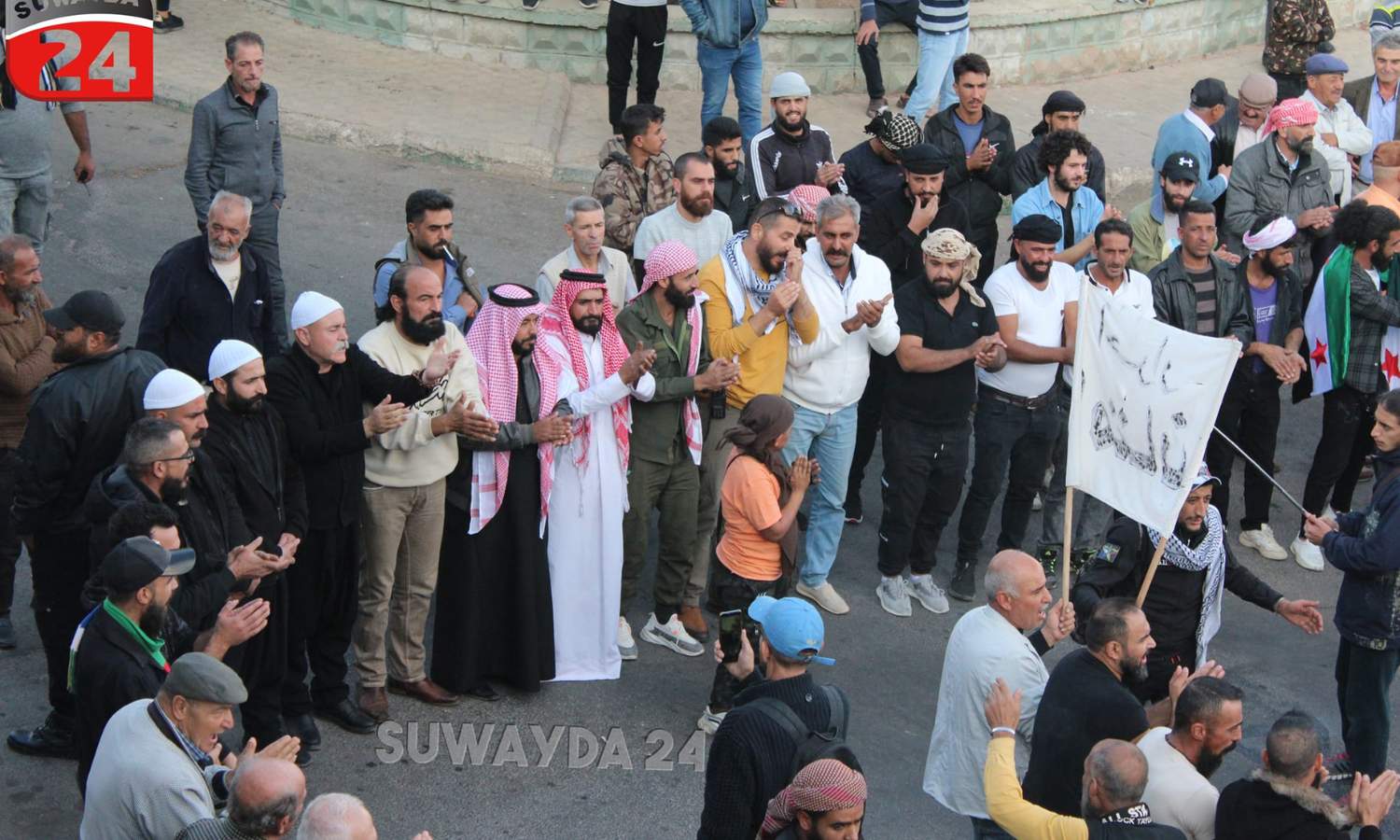
Protests in the town of Salkhad, south of As-Suwayda, calling for the overthrow of the Syrian regime and in solidarity with the people of the Gaza Strip – October 18, 2023 (Suwayda 24)
Why didn’t the Syrian cities join?
The As-Suwayda demonstrations coincided with the emergence of voices coming from the Syrian coast that attacked the Syrian regime and criticized the living conditions. They were preceded by the emergence of the “August 10” movement, followed by calls for demonstrations throughout Syria.
The cities of Daraa, As-Suwayda, Idlib, and the Aleppo countryside took part in demonstrations, but the main cities controlled by the Syrian regime, including Damascus, the capital, and the coastal cities where demonstrations were expected, were silent, and not a single case of demonstration was recorded, amid the regime’s tightening of the security situation.
The security tightening by the Syrian regime is not the only reason why Syrian cities, especially the coastal cities, did not go to the streets in demonstrations during the last two months, as there are political reasons related to several steps taken by the Syrian regime.
The rate of interaction with the As-Suwayda demonstrations can be divided according to the political conditions existing in the various Syrian regions and the distribution of control over them from different parties.
According to the advisor of the opposition’s Syrian Negotiations Commission (SNC), Dr. Yahya al-Aridi, who is from the city of As-Suwayda, the absence of encouragement from some influential actors to participate played a role in delaying participation, and the conditions of both the northwestern and eastern regions also had an impact.
According to al-Aridi, the lack of similarity in conditions between northeastern Syria and As-Suwayda and the latter’s distance from the parties controlling that region played a role in a weak interaction with the demonstrations, despite the demonstrations in several cities during the first days.
Some residents in the northwestern regions and the Aleppo countryside focused on details related to the As-Suwayda movement in the northwestern regions and the Aleppo countryside, specifically the constant presence of the five-color Druze flag and fears that the movement belonged to the sect, which led to a gradually fading interaction with As-Suwayda, while the the security grip and the regime’s mobilization played a role in preventing the coast from participating, in al-Aridi’s opinion.
Since the first days of the Syrian revolution in 2011, the Syrian regime has sought to isolate the Syrian governorates and segments of society from each other by exploiting loopholes and weaknesses that it worked on throughout the years of its rule, including regional, tribal, and sectarian.
As-Suwayda was not immune to these regime moves, and the assistant researcher fellow at the Omran Center for Strategic Studies, Yaman Ziad, believes that the regime, by creating security incidents between the people of the governorate and the tribes in the vicinity of Daraa, and the Bedouin tribes, and transferring Islamic State (IS) members and using them against As-Suwayda, succeeded in isolating the latter from its surroundings.
The security grip imposed in Daraa, the reconciliations, and the policy of emptying the Syrian governorates of their youth, whether through displacement or facilitating their exit from the country, as well as the battles it was exposed to and the changing composition of the population, played a role in the weak interaction, according to Ziad.
According to United Nations figures, there are 5.3 million Syrian refugees in the countries neighboring Syria, in addition to Syrians in European countries, and areas controlled by the Syrian regime are witnessing a large migration outside the country in search of better life opportunities.
|
The regime succeeded in isolating As-Suwayda by creating security incidents between the people of the governorate, the tribes in the vicinity of Daraa, and the Bedouin tribes, and transferring Islamic State members and using them against it. Yaman Ziad – A Researcher Fellow at the Omran Center for Strategic Studies |
With the increase in anti-Syrian regime voices on the coast, al-Assad visited the cities of Baniyas and Latakia, as well as his wife, Asma al-Assad, who visited the countryside of Tartus, in addition to visits carried out by ministers in the Syrian regime’s government.
The regions of Syria, in general, are experiencing an economic crisis in light of weak salaries and purchasing power, and high prices at the same time. Most residents rely on foreign remittances sent from their relatives outside Syria to help with living expenses.
Meanwhile, the popular incubator in the coast suffers in particular, given that it is the Syrian component least connected to immigrants outside the country.
Professor of Sociology Talal al-Mustafa told Enab Baladi that al-Assad’s visits to the coast, his direct threats to its residents in a state of collective revenge from other sects if they abandoned him, and his claim that other cities would not forgive what happened over the past years, instilled fear in people’s souls. One of the reasons that stopped the possibility of protests moving from individual to collective.
The sociologist added that other cities were emptied of their youth and demolished, as were the countryside of Damascus, Aleppo, Homs, and other Syrian cities, and these are fundamental reasons for the lack of interaction, according to his opinion, and the remaining residents of these cities are still under the shock of mass massacres and the use of chemical weapons against Syrians in several areas by the regime.
Hope remains for a possible popular rally
Although two months have passed since the As-Suwayda movement, and the absence of significant indicators indicating the possibility of popular demonstrations in the areas controlled by the Syrian regime, this does not prevent the possibility of momentum returning during the coming period, despite the steps taken by al-Assad, especially since the first reasons that sparked the possibility of movement still exists, as the economic situation has not improved, the stagnation still surrounds the political file, and the social crises surrounding the Syrians continue as well.
The continuity of the As-Suwayda movement may constitute an additional factor encouraging other Syrian governorates to come out against al-Assad, according to al-Aridi, who believes that the continuation and stability of the movement, extending its hand to all Syrians and increasing the level of understanding of its characteristics may play a role in the next stage.
The success of the As-Suwayda movement in seizing and achieving economic and political gains in the coming period will also play an important role in the expansion of the demonstrations to other Syrian cities controlled by the Syrian regime, especially since the latter has not succeeded in resolving any of the current crises besieging the residents of its regions.
Fellow researcher Yaman Ziad told Enab Baladi that Latakia and Tartus are the cities most prepared for popular movement, despite the tight security grip in them, but the increasing pace of security events in the two governorates, coinciding with the deterioration of economic conditions, may lead to some kind of movement, regardless of how extensive it is.
While al-Aridi believes that the continuation and stability of the popular and political movement in As-Suwayda could eventually lead to encouraging Syrians to go out into new areas against the Syrian regime, despite al-Assad issuing several decrees during the past two months, within the military and economic fields, including ending the work of field military courts.
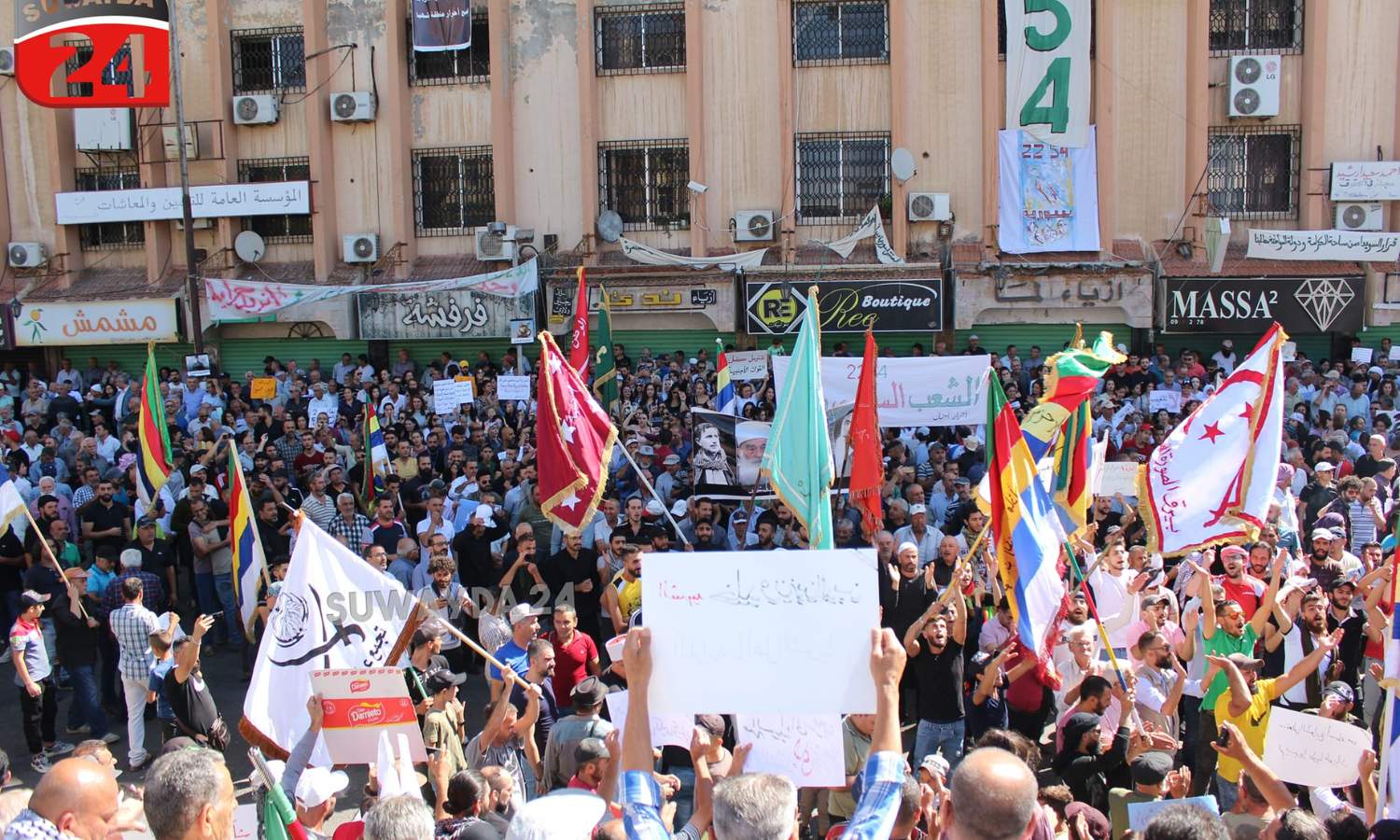
Demonstrations in the city of As-Suwayda in the main Square calling for the overthrow of the Syrian regime and in solidarity with the people of the Gaza Strip – October 13, 2023 (Suwayda 24)
‘Timid’ international position
The regime did not take any security measures publicly against the As-Suwayda demonstrations that would escalate its position further. On the other hand, the security grip tightened in other governorates to prevent the demonstrations from taking place in conjunction with calls for them, according to what Enab Baladi monitored.
Political analyst Firas Ridvan Oglu believes that the regime’s handling of the demonstrations in As-Suwayda so far is “very different” from its handling of the protests in other regions because he is aware of international sympathy for the people of As-Suwayda as they are part of the “Druze community.”
What prevented the regime from escalating in As-Suwayda was its concern about the position of Jordan or Israel in the south, as it appears that they do not want any military escalation in the region, and neither does Russia, according to Ridvan Oglu.
Salem of the Dimensions Center said that international interaction is of great importance in the continued steadfastness of the demonstrators in As-Suwayda and giving them the “moral dose” to continue, but it is currently excluded due to the current international events, in reference to the escalation between Israel and Hamas.
Salem added that the international interaction that has taken place up to this point, in addition to the efforts of the Syrian opposition and the various Syrian bodies representing the Syrian people, can contribute to stopping the rolling of the “wheel” of normalization with the regime, and this in itself is a “major achievement,” as he put it.
On September 27, US Deputy Assistant Secretary of State Ethan Goldrich made a call to the spiritual leader of the Druze sect, Sheikh Hikmat al-Hajri, to express his country’s support for freedom of expression for Syrians.
According to what was published by the American Embassy in Syria at the time, the United States supports the peaceful protest in As-Suwayda, and Goldrich confirmed the American calls to reach a “just and united Syria,” calling for a political solution consistent with Security Council Resolution “2254.”
On October 5, the French special envoy to Syria, Brigitte Curmi, made a phone call with Sheikh Hikmat al-Hajri and discussed with him the importance of the peaceful movement in As-Suwayda governorate, the effective participation of women and the necessity of implementing UN Resolution “2254.”
Al-Hajri also received a call from the British envoy to Syria, Anne Snow, on September 29, in addition to calls from the American Republican Representative French Hill, from the Democratic Representative Brendan Boyle, and from the European Parliament Member and Chair of the Foreign Affairs Committee, Katrin Langensiepen, responsible for the Syrian file from the “Greens” parliamentary bloc.
Al-Hajri is considered the symbol of the As-Suwayda movement, as he was the first spiritual leader to support the protests in the governorate before the second spiritual leader, Sheikh Hamoud al-Hinnawi, joined him.
Suleiman al-Kafiri, head of the As-Suwayda branch of the Arab Organization for Human Rights in Syria, believes that the movement in Syria is increasing in momentum and influence with the passage of days, and the positions supporting it internally are increasing in the Syrian governorates according to their circumstances, which suffer from the “security grip.”
Externally, the solidarity of Western and European countries with the Syrian movement is increasing, according to al-Kafiri, but he described it as “timid” and insufficient, and despite its good influence on the souls of the protesters, he nevertheless called for increased pressure on the regime to force it to begin moving towards implementing International Resolution “2254.”
Political analyst Firas Fahham believes that the ongoing escalation in Gaza “overwhelms the international scene,” which reduces interest in the As-Suwayda demonstrations, based on the fact that even the escalation that occurred in Idlib did not receive much international attention, with the exception of the interest of the guarantor countries in the Astana peace process and the discussions that took place between them.
Scenarios awaiting As-Suwayda movement
It seems logical to question the future of the demonstrations in the southern governorate with the rapid changes in the Middle East, the continuation of the movement for two months without a clear effect of achieving gains, or the expansion of the demonstrations to other areas controlled by the Syrian regime, and the latter’s lack of movement towards ending the movement once and for all.
The first scenario proposed is the expansion or decline of the momentum of the movement, whether in As-Suwayda and its environs or in other regime-held areas.
International changes and military battles in the region, and the shuffling of cards in them, also represent an opportunity for the regime to deal differently than it has shown since the outbreak of the demonstrations until now.
According to Firas Fahham, a researcher fellow at the Jusoor Center for Studies, the movement is slowly heading towards becoming weekly, while the regime may be heading towards escalation in light of current events and the international community’s preoccupation.
Fahham indicated, in his interview with Enab Baladi, that the regime had tried from the beginning, through media figures and newspapers close to it, to distort the movement and accuse the demonstrators of communicating with Israel.
The regime does not necessarily resort to military action or field incursion into the governorate, as it did in other Syrian cities for 12 years, as research assistant Yaman Ziad points out, as it has its tools to destabilize security in As-Suwayda, whether through militias or Islamic State fighters, which is something very likely, especially if it is linked to two factors.
Ziad explained that the first factor relates to As-Suwayda being able to open a land crossing with Jordan, forming a revolutionary enclave with Daraa and reaching other cities, or finding an economic solution without waiting for the regime to concede, which is the second factor.
The Syrian regime is betting on time and the decline in the momentum of the popular movement in the governorate, with economic restrictions imposed on the residents of As-Suwayda from time to time, according to Ziad.
The research fellow ruled out a direct military solution similar to what happened in the previously rebellious cities because the governorate has a demographic composition that extends outside the framework of Syrian geography.
In addition to the above, al-Assad is unable to formulate a narrative about the presence of extremists or terrorists in the city, and the most important reason is that the local factions supported by al-Assad and Iran may turn against him if there is a military solution, as the principle of “honor and land” occupies a great place among all the people of the governorate, according to his opinion.
Fahham suggested that the movement will continue during the coming period, coinciding with the region heading toward an unknown fate after the Gaza battles, which the regime will try to exploit to end the movement through a security solution.
In a previous interview with Enab Baladi, Laith al-Balous, the son of the founder of the Men of Dignity movement, Sheikh Wahid al-Balous, and the leader of what is known locally as the “Madafet al-Karamah, Dignity Guesthouse,” revealed attempts to coordinate between the military and political forces in As-Suwayda to create a “political council” that would give a new face to the governorate.
He pointed out that the project is being discussed with the political forces, with the aim of unifying efforts under one council and opinion.
At the time, al-Balous expected that the regime would not open a new front on the military level with the people of As-Suwayda, especially with the bad situation it is suffering from in light of the American presence a few kilometers east of the governorate (Al-Tanf garrison), he told Enab Baladi.
He added that al-Assad’s policy is clear today in the south, as he fights its people with starvation and as the security checkpoints on the Damascus-As-Suwayda highway deliberately prevent goods vehicles from entering the governorate, under the pretext that there are demonstrations there, noting that the demonstrators did not prevent goods vehicles from entering the governorate.
Al-Assad previously expressed, in an interview with the Abu-Dhabi-based Sky News Arabia on August 10, his way of dealing with the demonstrations in Syria, saying: “If we go back in time, we will build and adopt the same policy in handling the events in Syria.”
if you think the article contain wrong information or you have additional details Send Correction
النسخة العربية من المقال
-
Follow us :
Most viewed
- Al-Sharaa and Abdi reach agreement on merger of SDF into Syrian state
- Syrian Defense Ministry appoints "Abu Amsha" as Hama Brigade commander
- No financial flows to Syria despite partial lifting of sanctions
- Turkey confirms continuation of its operations in northeastern Syria
- Governor of As-Suwayda signs understanding agreement with al-Hijri: Key details unveiled












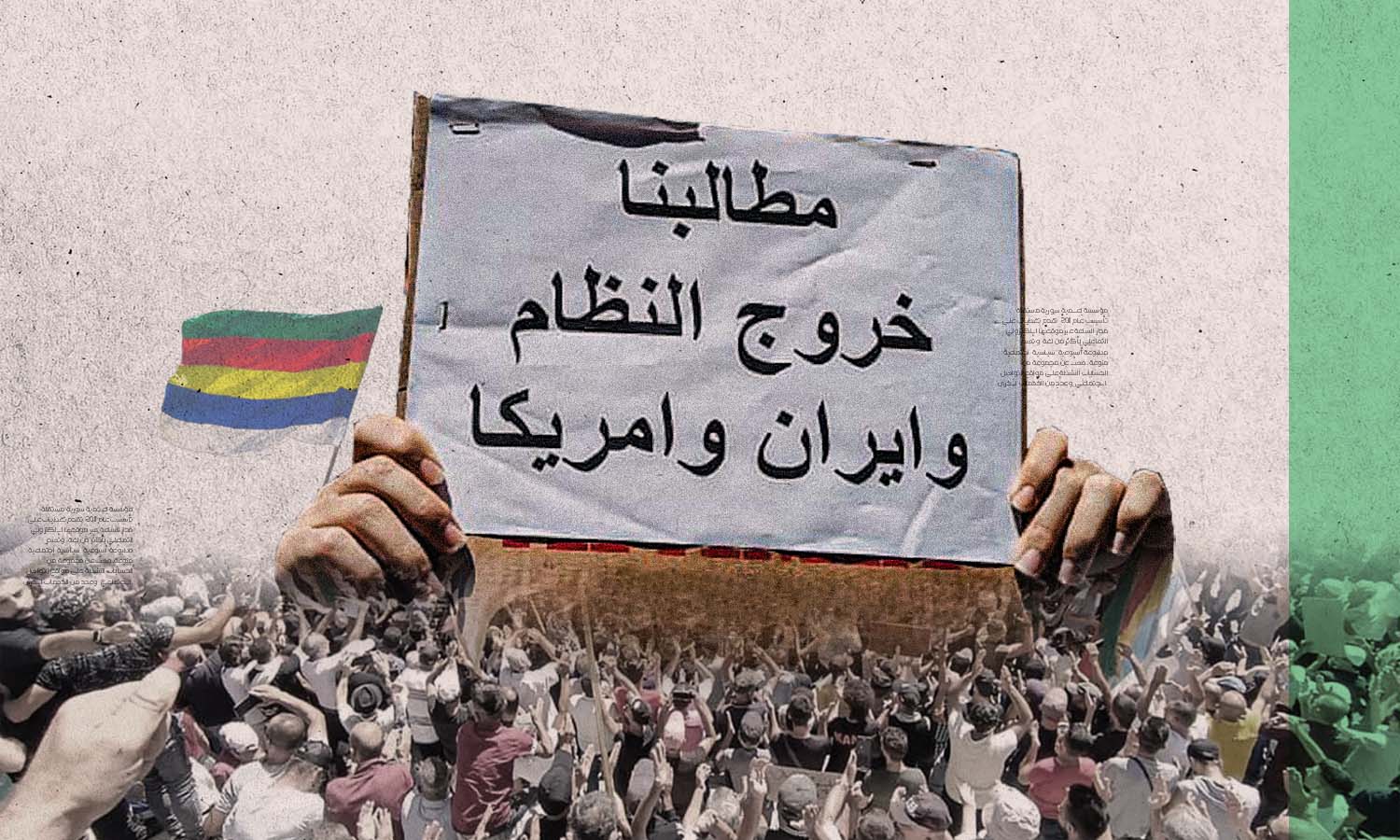
 A banner raised at the As-Suwayda demonstrations calling for the overthrow of the Syrian regime and the exit of American forces and Iranian militias from Syria - October 2023 (Edited by Enab Baladi)
A banner raised at the As-Suwayda demonstrations calling for the overthrow of the Syrian regime and the exit of American forces and Iranian militias from Syria - October 2023 (Edited by Enab Baladi)





 A
A
A
A
A
A
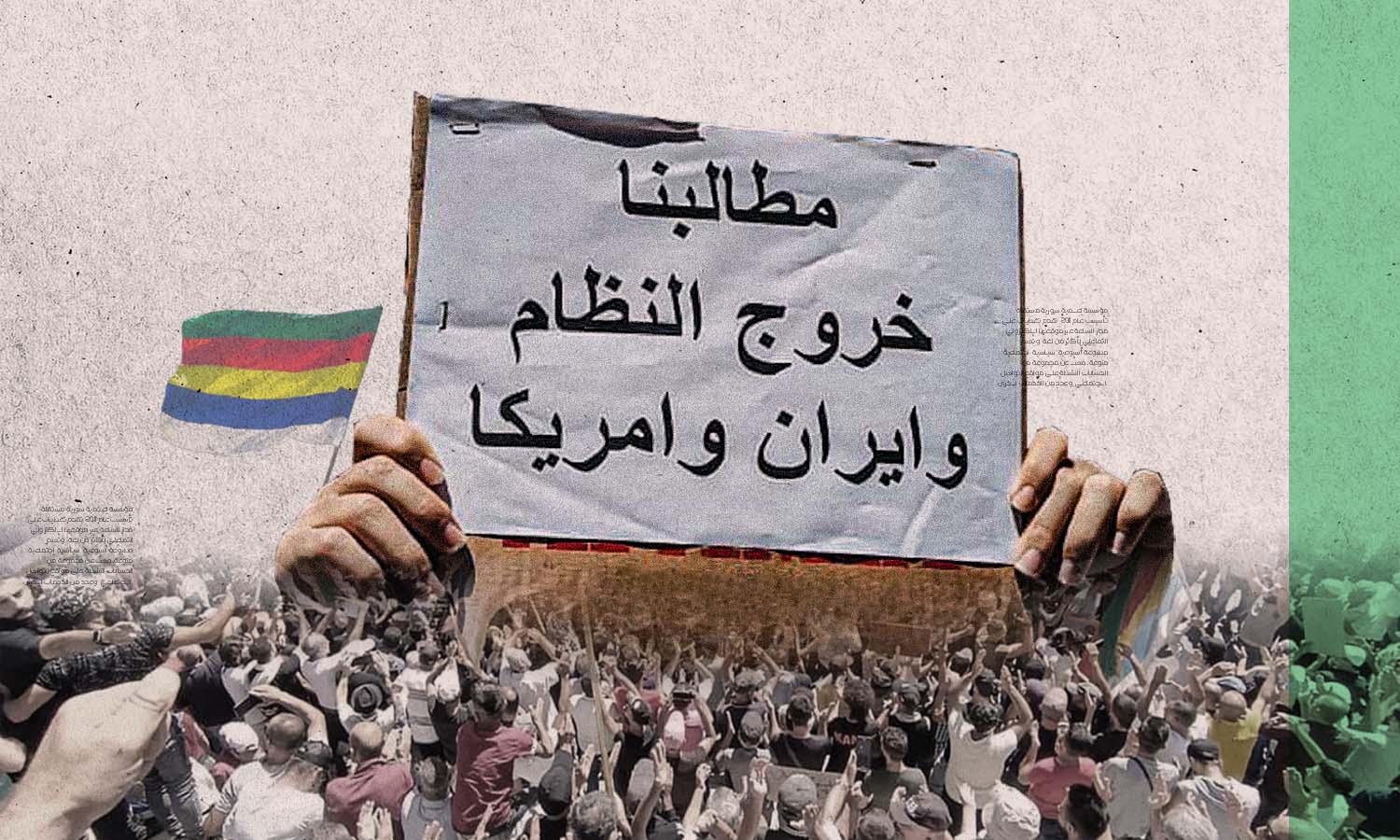


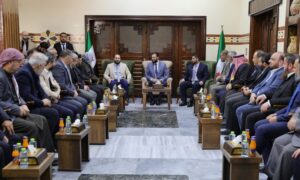
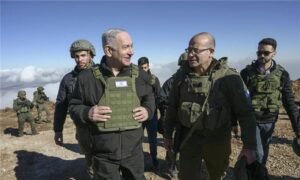
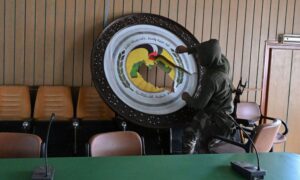
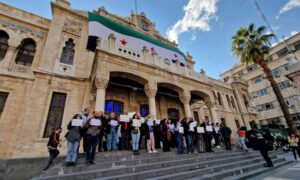
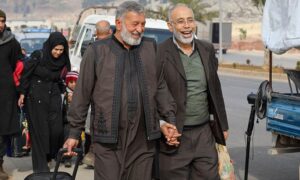
 More In-Depth
More In-Depth